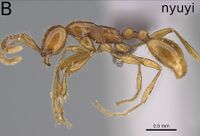Aenictus nyuyi
| Aenictus nyuyi | |
|---|---|

| |
| Scientific classification | |
| Kingdom: | Animalia |
| Phylum: | Arthropoda |
| Class: | Insecta |
| Order: | Hymenoptera |
| Family: | Formicidae |
| Subfamily: | Dorylinae |
| Genus: | Aenictus |
| Species group: | rotundatus |
| Species complex: | rotundatus |
| Species: | A. nyuyi |
| Binomial name | |
| Aenictus nyuyi Gomez, 2022 | |
Known from a single collection site. The type series was found in a 2017 Senegal gallery-forest winkler sample. A 2018 resampling of this same site yielded more workers.
Identification
Gómez (2022) - A member of the rotundatus species complex in the Aenictus rotundatus species group. Exceptionally long scapes (SIL>80, against SIL<75 for the rest of species in the group) makes this species easily recognizable. Also, the lack of developed subpetiolar process separates it from the rest of species in the rotundatus complex except for Aenictus weissi, but these two are differentiable due to the absence of propodeal ridge against a well-developed one in A. weissi.
Keys including this Species
Distribution
Latitudinal Distribution Pattern
Latitudinal Range: 12° to 12°.
| North Temperate |
North Subtropical |
Tropical | South Subtropical |
South Temperate |
- Source: Gomez, 2022
Distribution based on Regional Taxon Lists
Afrotropical Region: Senegal (type locality).
Distribution based on AntMaps
Distribution based on AntWeb specimens
Check data from AntWeb
Countries Occupied
| Number of countries occupied by this species based on AntWiki Regional Taxon Lists. In general, fewer countries occupied indicates a narrower range, while more countries indicates a more widespread species. |

|
Estimated Abundance
| Relative abundance based on number of AntMaps records per species (this species within the purple bar). Fewer records (to the left) indicates a less abundant/encountered species while more records (to the right) indicates more abundant/encountered species. |

|
Biology
Castes
Known from the worker caste. Table of castes known for all Afrotropical Aenictus species.
Nomenclature
The following information is derived from Barry Bolton's Online Catalogue of the Ants of the World.
- nyuyi. Aenictus nyuyi Gómez, 2022: 71, figs. 54A-D, 55 (w.) SENEGAL.
- Type-material: holotype worker, 9 paratype workers.
- Type-locality: holotype Senegal: Kedougou, Afia Forest (Dindefelo), 395 m., 12.36497, -12.3049, 15.vii.2017, Winkler (A. Diallo); paratypes with same data.
- Type-depositories: BMNH (holotype); AFRC, BMNH, CASC, HGPC, ISNB, KGPC, MHNG, SAMC, YKPC (paratypes).
- Distribution: Senegal.
Unless otherwise noted the text for the remainder of this section is reported from the publication that includes the original description.
Description
Worker
HL: 0.61 [0.57-0.63]; HW: 0.51 [0.47-0.54]; SL: 0.49 [0.46-0.53]; WL: 0.98 [0.90-1.07]; PL: 0.22 [0.20-0.25]; PH: 0.15 [0.13-0.17]; PPL: 0.17 [0.15- 0.19]; PPH: 0.13 [0.12-0.15]; CS: 0.56 [0.52-0.59]; CI: 83 [82-85]; SIL: 81 [79-84]; SIW: 97 [95-100]; WL/HW: 191 [181-196]; PI: 149 [142-161]; PPI: 128 [121-133]; CSR: 112; (n=10).
Scapes relatively long, surpassing three quarters of head (SIL ~ 80). Funicular segments elongated, apical twice and a half times longer than wide. Head rectangular, longer than wide (CI~83), convex laterally and widest at the middle. Occipital line straight to slightly convex. ventrolateral margin not developing ventrally.
Mandibles triangular with a long, sharp apical tooth and 5–7 smaller denticles, usually eroded. Frontal ridges present, not fused and not projecting frontally.
Pronotum convex, mesonotum a straight line, propodeum slightly elevated over mesonotum, with a small anterior straight face and flat dorsum, mesopropodeal suture weak. Transverse mesopleural and mesometapleural sutures present but weak; propodeal ridge present as a thin ridge, conspicuous; propodeal declivity concave.
Petiole subsessile with anterolateral and anterodorsal ridges present, dorsolateral ridge present, weak and short, reaching the petiolar spiracle. Petiole with an anterior slope straight to rounded, dorsally rounded and vertical posteriorly, posterodorsal angle straight and rounded. Postpetiole subrectangular, rounded, with vertical anterior and posterior faces, without carinae or ridges. Subpetiolar process poorly developed as an ellipse clearly longer than high without lamella with a small triangular extension anteriorly, similar in size to prora.
Mandibles finely horizontally rugulose, shagreened; whole body glassy smooth except for; the reticulated mesopleurae, propodeum, lateropetiole and lateropostpetiole from alutaceus to reticulated. Some workers with smooth propodeum patches dorsally and laterally. Some short rugulae may appear on meso-metapleural suture and continue on lateropropodeum. Overall colour light brown to brown.
White, scattered, moderately long, decumbent to semierect setae present at head, scapes, dorsum of pronotum, petiole, postpetiole, gaster and legs. Dorsopropodeum bare. No pubescence noted.
Type of A. rotundatus var. merwei are smoother, with dorsopropodeum, petiole and postpetiole at most alutaceus and propodeal reticulation feeble, almost smooth at some individuals.
Scattered decumbent white setae, shorter than petiole height, oriented backwards, present at head, dorsum of pronotum petiole, postpetiole and gaster. Dorsum of propodeum bare except for its posterior border, with 2–4 long erect setae. A few scattered, long, white, erect setae present at pronotum, petiole, postpetiole and gastral tergites, longer than petiole height.
Scapes with white unequally long semierect setae, clearly longer than scape width. No pubescence noted.
Type Material
- Holotype worker, SENEGAL: • Kedougou, Afia Forest (Dindefelo) 395m, 12.36497, -12.3049 15/07/2017. Winkler (Diallo, A.). Gallery For. (1w) [KGCOL00560] The Natural History Museum.
- Paratype workers: • same series (1w) [KGCOL00561] BMNH; (1w) [KGCOL00562] CASC; (1w) [KGCOL00563] MHNG; (1w) [KGCOL00564] RBINS; (1w) [KGCOL00565] FHGC; (1w) [KGCOL00566] SAMC; (1w) [KGCOL00567] AFRC; (1w) [KGCOL00568] YKPC; (1w) [KGCOL00569] KGPC.
Etymology
The species name nyuyi is a non-Latin noun used in apposition and is the Fula word for ‘small ant’.

